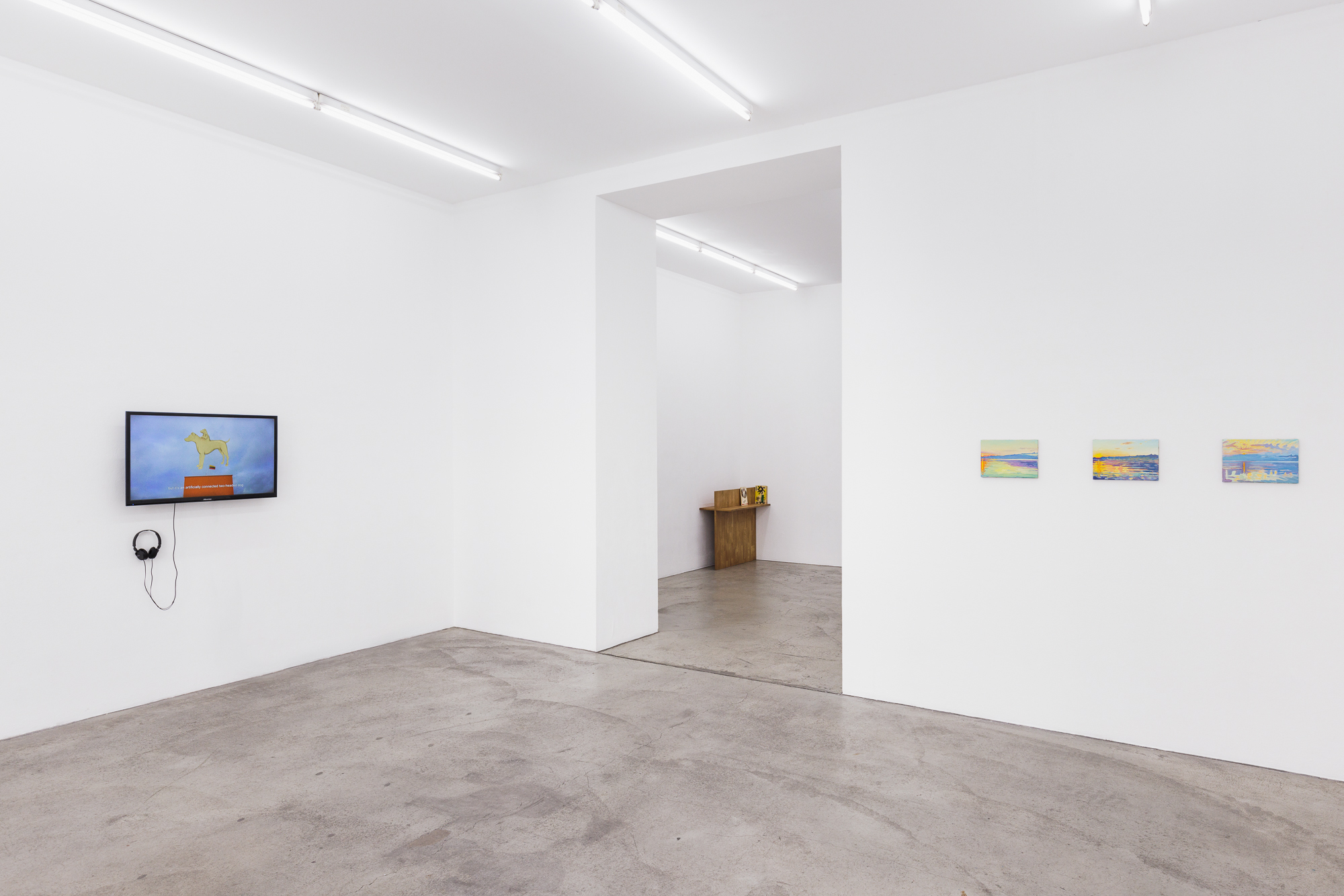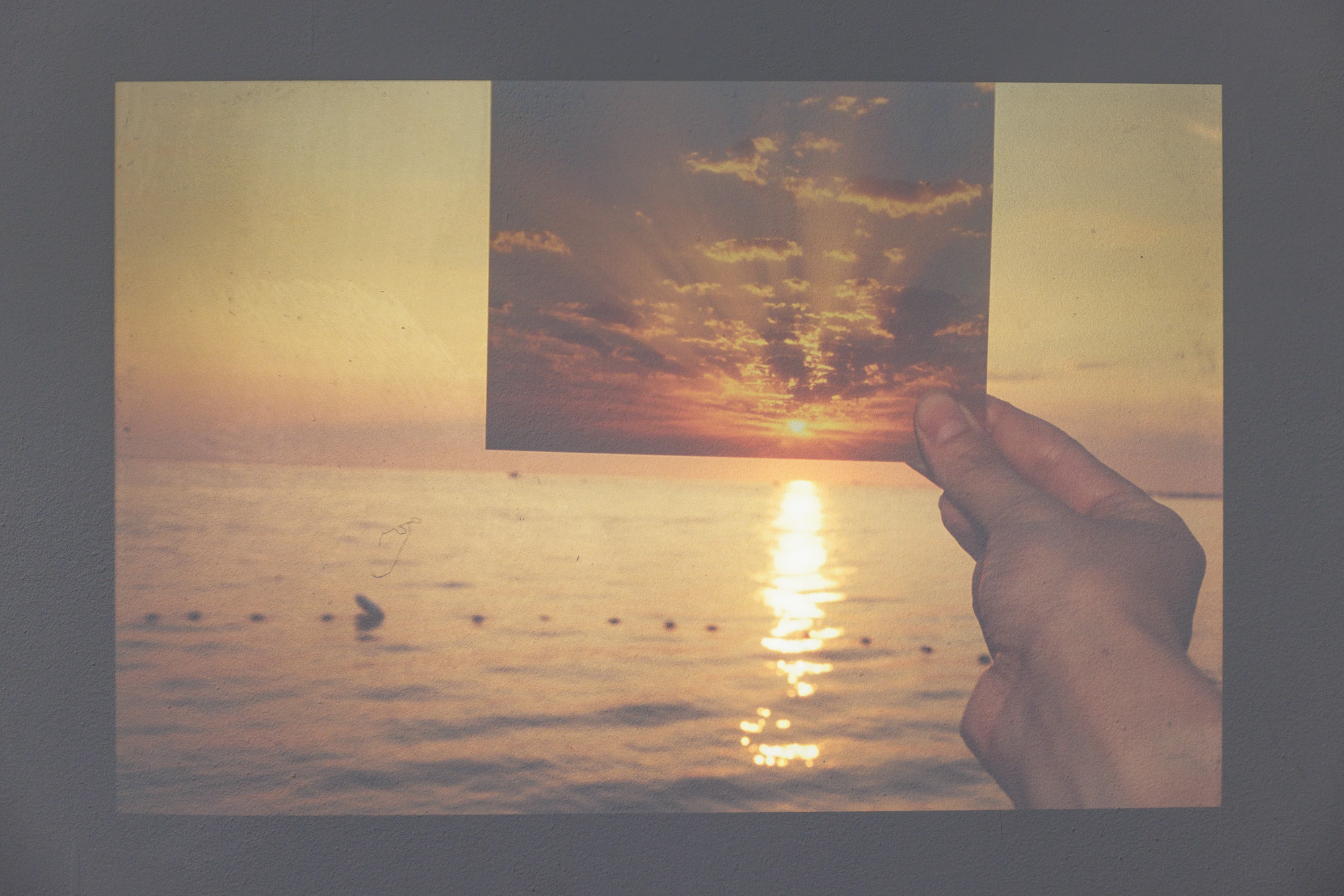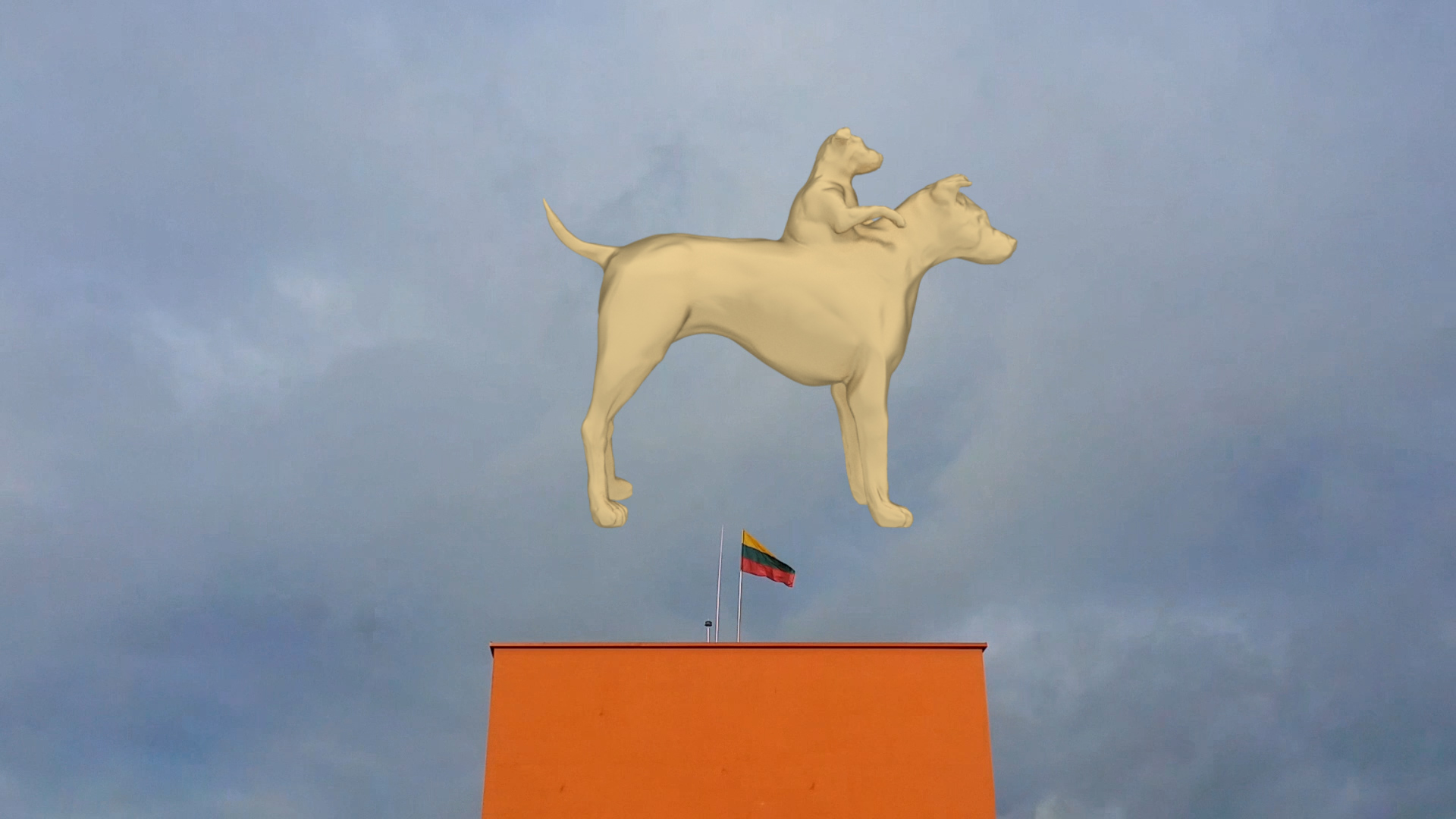
Anastasia Sosunova
Demikhov Dog (still), 2017
Courtesy: the artist and the National Gallery of Art, Vilnius
Café del Mar
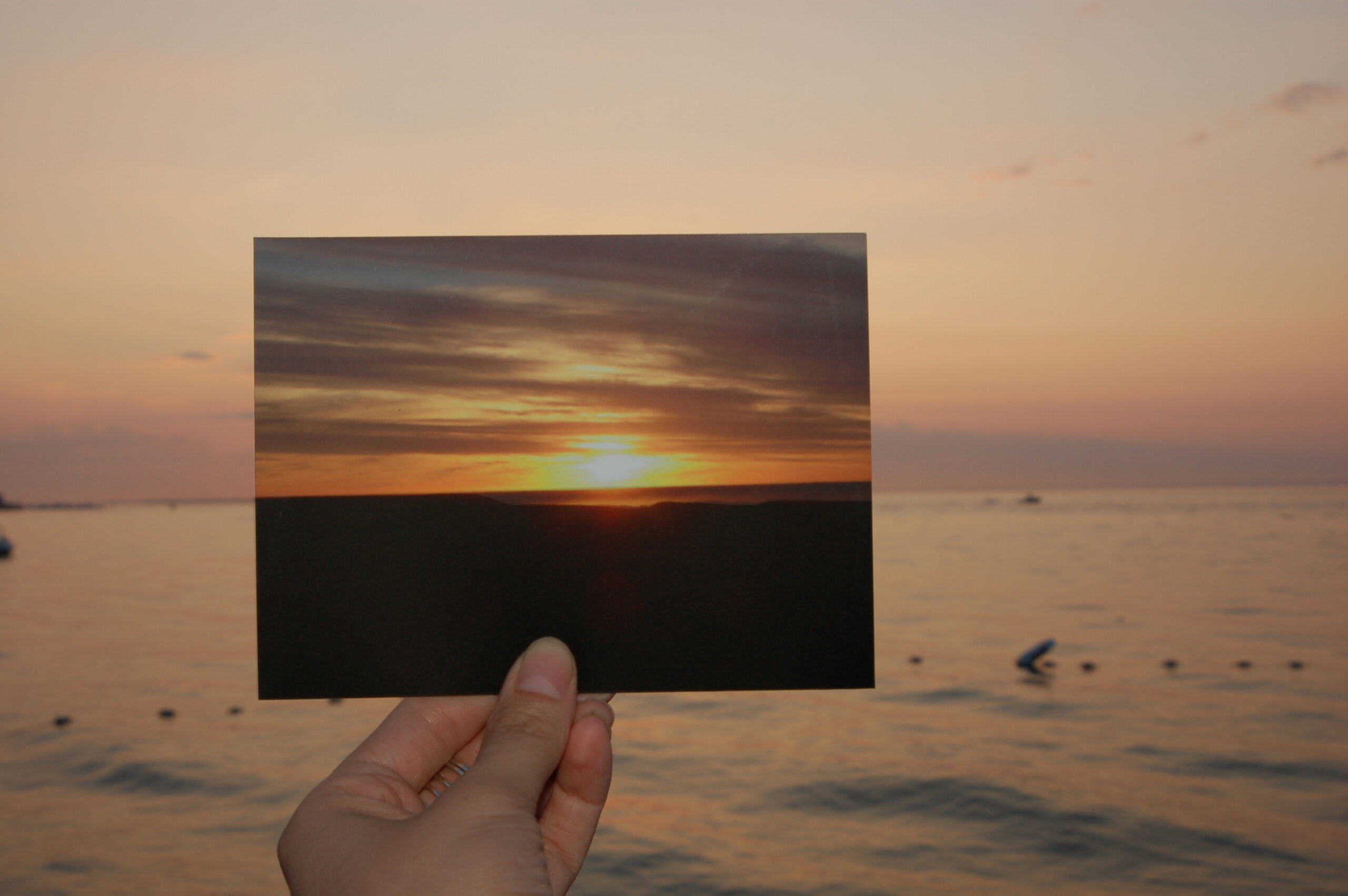
Lisa Oppenheim
The Sun Is Always Setting Somewhere Else, 2006
Looped slide projection of 15 slides, 35mm Kodak Ektagraphic Slide Projector Variable dimensions
Edition of 4, 1AP
Courtesy: the artist and Tanya Bonakdar Gallery, New York / Los Angeles
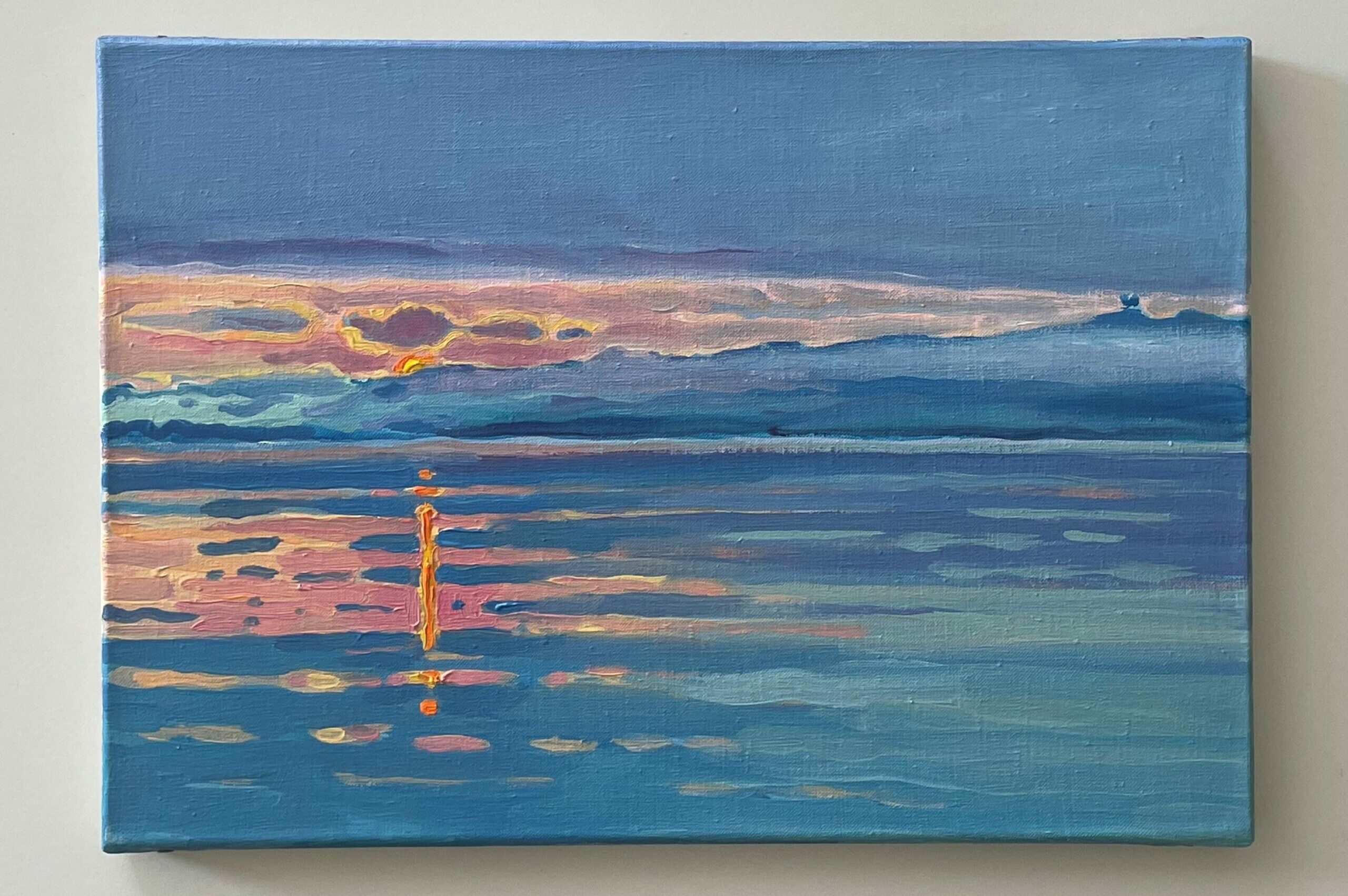
Jean-Frédéric Schnyder
Sonnenaufgang am Zugersee, 17. September 1996, 1996
oil on canvas
21 x 30 cm
Courtesy: Kunsthaus Zug
Die Ausstellung blickt auf Grenzen und deren Auflösung. Dabei geht es um die Identität und Verbundenheit kultureller Räume, vor allem aber um die Migration von Zeichen und ihren Bedeutungen, deren Verschiebung und Hybridisierung. Im Zentrum steht die zuletzt wieder zunehmend scharf gezeichnete Trennlinie zwischen Ost und West, Orient und Okzident, die in ihrer Klarheit nicht zu halten ist und im Bild zum Verschwinden gebracht wird. Der symbolischen Schwere des Sonnenunter- und aufgangs als kultur- und politprogrammatische Chiffre wird das immer wiederkehrende Naturschauspiel als bildliche Korrektur entgegensetzt, die inhaltlich erleichtert den Blick in Richtung Sinnoffenheit und -pluralität lenkt. Die Sonne und andere Motive stellen sich in unübersichtlicher semantischer Breite dar, während harte elektronische Sounds aus dem Untergeschoß der Galerie den Beginn oder das Ende der Party einläuten.
Eine Ausstellung zwischen Buchstäblichkeit und Metaphorik, High und Low, Sundowner und Untergang. Ein Szenario der Unschärfe, an der Schwelle zur Dunkelheit.
—
Jean-Frédéric Schnyder (geb. 1945 in Basel) steht mit seiner antizyklisch entwickelten, unmittelbaren Malerei des Alltäglichen, konsequent betrieben seit den konzeptkunstdominierten 1970ern, im Zentrum der Ausstellung. Wir sehen zehn Sonnenaufgänge am Zugersee, aus einer Serie von insgesamt 27 Bildern, gemalt zwischen dem 12. Juli und dem 27. Dezember 1996, immer dann, wenn die Sonne zu sehen war. Pop so klar wie die frische Morgenluft, traditionelle Pleinair-Malerei verbunden mit konzeptueller Kühle. Im Hintergrund scheint jedoch eine massive Front heranzuziehen, eine Fundamentalkritik an visueller Repräsentation: Die Serie der immer wieder gemalten immer wiederkehrenden Sonne ist keine Parade des Banalen, sondern eine Auffächerung von Kontingenz und abnehmender Signifikanz. Von Bild zu Bild häufen sich Zweifel, was Bilder jenseits des Gezeigten überhaupt bedeuten können.
Anastasia Sosunova (geb. 1993 in Ignalina, Litauen) setzt sich in ihrem Video Demikhov-Dog mit Fragen kultureller Identität und Zugehörigkeit auseinander, die unmittelbar sie selbst als Litauerin aus einer Russisch sprechenden Familie betreffen. Der Hund im Titel ist benannt nach dem sowjetischen Wissenschaftler Wladimir Demichow, der 1954 die ersten Kopftransplantationen der Welt durchführte und dabei zweiköpfige Hunde schuf, die tatsächlich für kurze Zeit überlebten. „Das für die Arbeit verwendete Filmmaterial“, so die Künstlerin, „wurde in der gesamten baltischen Region gesammelt und mit fiktiven Charakteren, chimärenhaften, animierten Realitäten und nicht ganz litauischen Geschichten kombiniert.“ Die wundersame Hunde-Kreatur wird damit nicht nur zum Ausdruck für die multiple narrative Struktur des Videos, sondern auch allgemein eines hybriden kulturellen Selbstverständnisses, das ein vereinfachtes Denken in Dichotomien wie Ost und West hinter sich lässt.
Plamen Dejanoff (geb. 1970 in Sofia) steht künstlerisch für Transfer und Hybridisierung schlechthin: von Ost und West, Eigenem und Fremdem, Historischem und Zeitgenössischem. In Bulgarien, das in seiner Geschichte unter wechselndem muslimischem und christlichem Einfluss stand, seit jeher also am Übergang von Orient und Okzident, betreibt der Künstler eine Stiftung, die sich der Erhaltung und Wiedererrichtung der historischen Hauptstadt Veliko Tarnovo widmet. Die daraus abgeleiteten Rekonstruktionen und Nachbildungen kulturell bedeutender Gebäude und einzelner Bauelemente wie The Bronze House oder The Bronze Theater bewegen sich zwischen autonomer künstlerischer Arbeit und materiell hochgetunter Stiftungswerbung. Auch im Fall des in den 1960ern erschienenen tschechoslowakischen Kunst- und Literaturmagazins plamen (auf Deutsch: Flamme), das der Künstler auf Basis der Namensgleichheit als das eigene ausgibt, bleibt vieles unklar. Die großzügige Auslegung dessen, was anderen oder einem/r selbst gehört, weist in zwei Richtungen: 2010er Appropriation Art und/oder ironisch geballtes Balkan-Klischee.
In den Dias von Lisa Oppenheim (geb. 1975 in New York) kreuzen sich zwei Kreisläufe, die der Sonne und die ihrer Bilder. Man sieht jeweils einen von der Künstlerin fotografierten Untergang in New York, vor den sie das Foto eines Sonnenuntergangs im Irak hält, jeweils von US-Soldaten aufgenommen und auf Flickr hochgeladen. Diese Doppelung wirft die Assoziationsmaschine an, die untergehende Sonne lädt sich mit Bedeutungen und Fragen auf, politischen und medienreflexiven: Wird hier die globale Rolle Amerikas – überall und am Verschwinden – kommentiert? Ist die Simultanität der Untergänge Sinnbild für die Auswirkungen des Digitalen auf die Produktion und Verteilung der Bilder, die virtuelle Verkürzung von Raum und Zeit? Am Ende bleibt der Eindruck von Störung und Destabilisierung: Die Schönheit des Naturvorgangs wird medial gebrochen, ein Sonnenbild verdrängt das andere, die Verdunkelung ist im vollen Gange.
Bei den Arbeiten von Gina Fischli (geb. 1989 in Zürich) wird die ironische Brechung der geographischen Einteilung politischer oder kultureller Räume nochmal verschärft. Ihre beiden „Fenster“ (wie auch die restlichen der Werkgruppe) sind so gut wie identisch und lassen sich fast nur anhand ihrer Betitelung nach verschiedenen Himmelsrichtungen auseinanderhalten. Sie nehmen damit unmittelbar Bezug auf ihren Entstehungskontext, die lähmende Zeit der Covid-Lockdowns: die Nivellierung aller Aussichten und Bedeutungen, der Tiefpunkt jeder Signifikanz. Oder genau umgekehrt, der große Moment der Zeichen: Wenn in der Isolation alles in seiner Ungreifbarkeit austauschbar wird, kann alles vieles bedeuten.
Für Tomasz Kowalskis (geb. 1984 in Szczebrzeszyn, Polen) Beitrag ist die Ausstellung an sich eine Kontextverschiebung. Sein Holzobjekt war bereits 2010/11 Teil einer Einzelausstellung in der Galerie. Es wird hier im Sinne der Nähe des Künstlers zu einem „neuen Surrealismus“ als zeitliches Treibgut oder Objet trouvé integriert und kommt titelgemäß als (zu niedriges, merkwürdiges, religiös konnotiertes) Regal zum Einsatz.
Markéta Othová (geb. 1968 in Brno) arbeitet im Medium der Fotografie und zeigt in der Ausstellung eine Serie von abstrakten Kompositionen, die am Computer entstanden und anschließend fotografiert wurden. Die konzentrisch aufgebauten, konsequent durchdeklinierten Kombinationen von Kreisen haben einen persönlich-emotionalen Entstehungshintergrund und stellen eigentlich Blumenmuster dar. Im Kontext der Ausstellung treten sie aber in neue Referenzverhältnisse: strahlende Sonnen, Sterne, pulsierende Lichter oder Variationen des Love Parade-Logos. Die Kreise öffnen und schließen sich.
Natalia Martynenko ist DJ, Kuratorin und Radiomoderatorin aus Kiew. Sie experimentiert gerne mit einer Vielzahl elektronischer Musikgenres und kombiniert dabei Leftfield-Motive mit rohen und dekonstruierten Sounds. https://soundcloud.com/natalia_martynenko
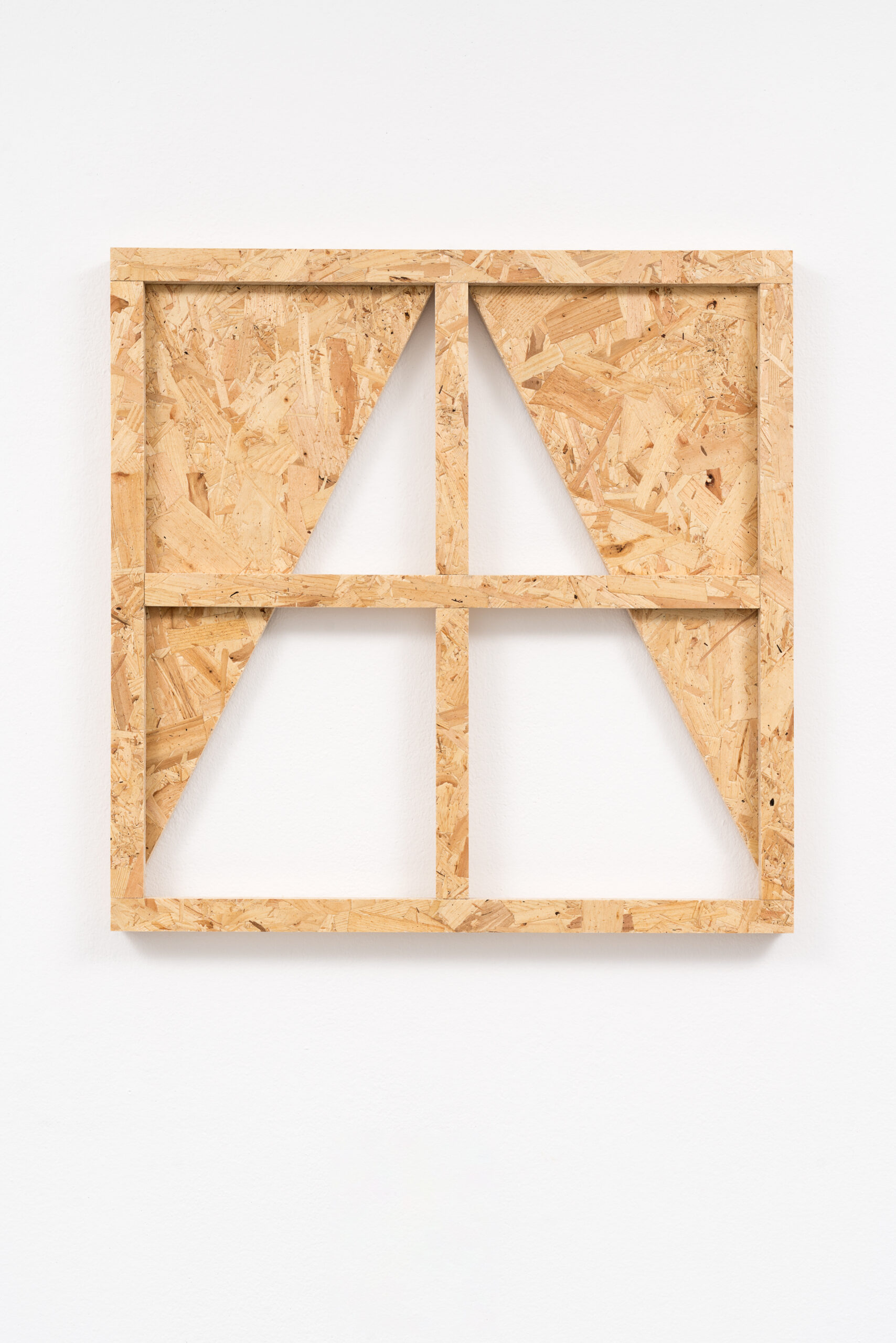
Gina Fischli
South West, 2021
OSB
72 x 72 x 4
Courtesy: the artist and SANDY BROWN, Berlin
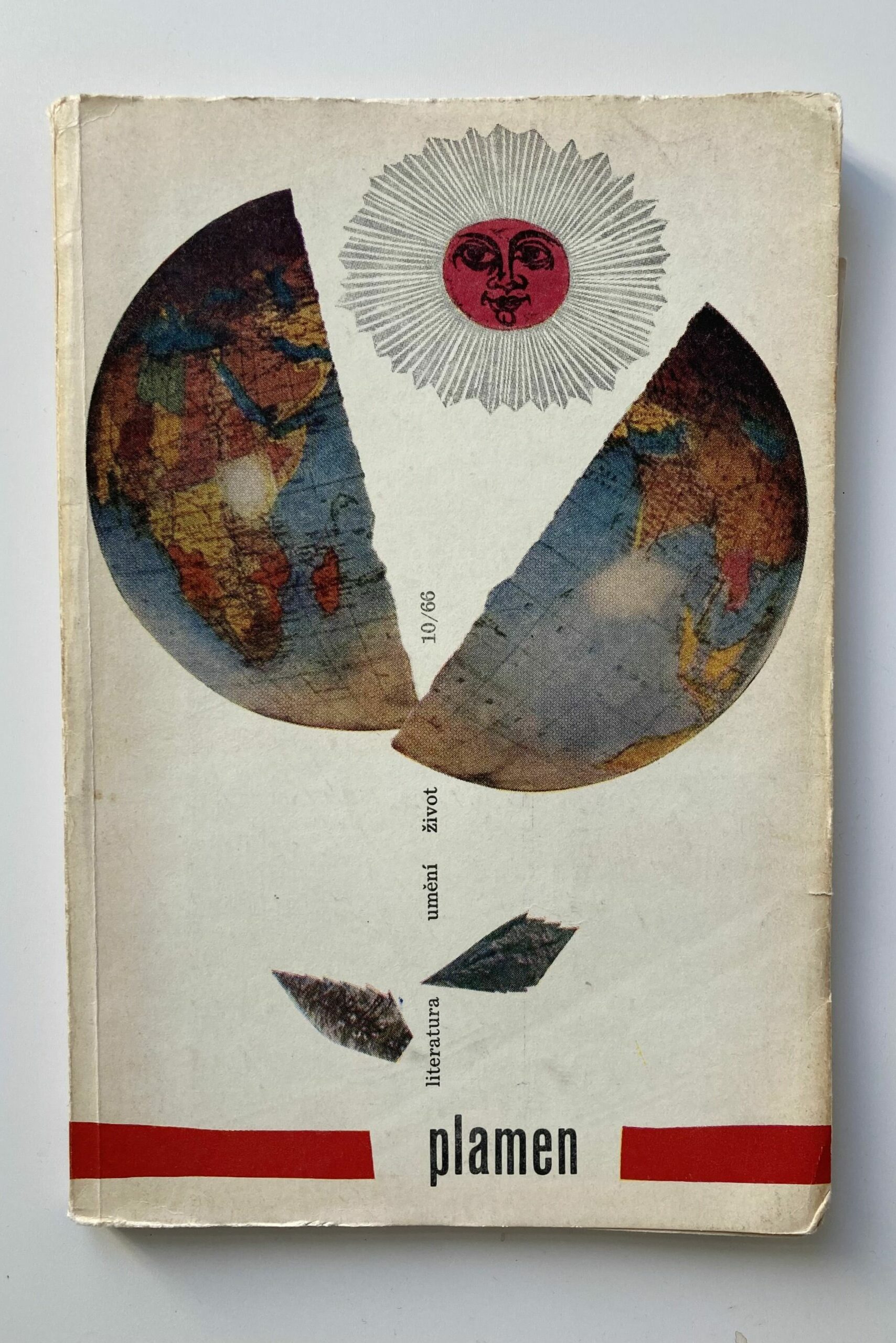
Plamen Dejanoff
plamen, 2015
original magazine from the 1960s
24,5 x 16,5 x 1 cm
Courtesy: the artist and LAYR, Vienna
The exhibition looks at borders and their dissolution. It is about political geography in Europe, the identity and connectedness of cultural realms, the migration of signs and their meanings, their recontextualization and hybridization. The focus is on the -recently again- sharply drawn dividing line between East and West, Orient and Occident, which cannot be maintained in its clarity and is challenged or contaminated by the works in the show. The symbolic weight of sunset and sunrise as a cultural and programmatic cipher in politics is countered by the recurring spectacle of nature as a pictorial correction that paves the way to openness and a plurality of meanings. The sun and other motifs present themselves in a confusing semantic breadth, while the rigor of electronic sounds from the basement of the gallery heralds the beginning or the end of the party.
An exhibition between the literal and the metaphorical, high and low, sundowner and eclipse. A scenario of blur on the threshold of darkness.
—
The work of Jean-Frédéric Schnyder (born in 1945 in Basel) is at the core of the exhibition. Since the heyday of Conceptual art in the 1970s, he has consistently made straightforward paintings of everyday scenes that go against the dominant tendencies of the art world. The exhibition features ten paintings from a series of twenty-seven works showing sunrises at Lake Zug, painted on days when the sun was visible between 12 July and 27 December 1996. Pop as clear and fresh as early-morning air; traditional plein-air painting combined with conceptual coolness. In the background a hefty cold front is looming, however: a fundamental critique of visual representation. These recurrent images of the recurring sun are not a pageant of banality, but rather an index of contingency and diminishing significance. As one moves from one picture to the next, the idea that pictures can mean something beyond what they depict becomes less and less plausible.
In her video Demikhov-Dog, Anastasia Sosunova (born in 1993 in Ignalina, Lithuania) explores questions of cultural identity and belonging that reflect her own background as a Lithuanian from a Russian-speaking family. The dog in the work’s title is named after the Soviet scientist Vladimir Demikhov, who performed the world’s first head transplants in 1954, creating two-headed dogs that even survived, albeit briefly. She explains: “The footage used in the work was collected throughout the Baltic region, and is combined with fictitious characters, chimeric animated realities and not quite Lithuanian stories.“ The wondrous hound-creature thus becomes a figure for the multiple narratives structuring the video as well as for a hybrid sense of cultural belonging that has moved far beyond simplistic dichotomies such as East and West.
Plamen Dejanoff (born in 1970 in Sofia) makes work in which ideas transfer and hybridization are paramount: East and West, what is one’s own and what belongs to others, historical and contemporary. In Bulgaria, which has been under alternating Muslim and Christian influence throughout its history, i.e., where Orient and Occident meet and merge, the artist runs a foundation dedicated to the preservation and reconstruction of the historic capital Veliko Tarnovo. The reconstructions and replicas of culturally significant buildings and individual building elements made in the context of this project, among them The Bronze House and The Bronze Theatre, are emphatically both standalone artworks and materially souped-up advertising for his foundation. Much remains unclear, too, in the case of the 1960s Czechoslovakian art and literary magazine plamen (in English: flame), which, given that they are identically named, the artist passes off as his own. Dejanoff’s extensive probing into questions of who owns what can be read both as a 2010s take on appropriation art and as a kind of stealing—which is to say, an ironic exaggeration of Balkan stereotypes.
Two circulatory systems intersect in the slide projections of Lisa Oppenheim (born in 1975 in New York): that of the sun and that of images of it. Each image shows a sunset photographed by the artist in New York, in front of which she holds a photo of a sunset in Iraq, taken by a US soldier and uploaded to Flickr. This duplication triggers a chain of associations, as the setting sun becomes charged with significance, with political questions and questions about media technologies. Is the work a commentary on America’s global role, mirroring how it is both ubiquitous and disappearing? Are the simultaneous sunsets emblematic of the effects of the digital on the production and distribution of images, a virtual short-circuiting of space and time? Viewers are left with an impression of disruption and destabilization: the mediated image interrupts the beauty of the natural process; one image of the sun displaces the other; darkness is falling apace.
The work of Gina Fischli (born in 1989 in Zurich) goes still further in undermining the geographical divisions of political or cultural spaces. Like the other works in this series, the two “windows” on view are almost identical and could barely be held apart were it not for their being titled after different cardinal points. In this way, they make direct reference to the context in which they were made, namely the paralyzing period of Covid lockdowns: the flattening of all perspectives and meanings, the low point of all significance. Or the exact opposite, the great moment of signs: when isolation makes everything interchangeable, since it is equally intangible, everything can mean many things.
For Tomasz Kowalski (born in 1984 in Szczebrzeszyn, Poland) the exhibition itself represents a shift in context, since his wooden object was already included in a solo show at the gallery in 2010–11. This time it is integrated as a piece of temporal flotsam or an objet trouvé, in keeping with the artist’s proximity to what has been called “new surrealism”. With its cruciform cross-section, it is deployed as some kind of strange shelf, taking the title at its word.
Markéta Othová (born in 1968 in Brno) works with the medium of photography. Here she presents a series of abstract compositions that were created digitally and subsequently photographed. The concentric construction and logical conjugation of these combinations of circles have a personal, emotional origin and actually represent flower patterns. In the context of the exhibition, however, they enter into new associative relationships: radiant suns, stars, pulsating lights or variations of the Love Parade logo. The circles open and close.
Natalia Martynenko is a DJ, curator, and radio host from Kyiv whose delicate aesthetic attitude loves to experiment with a variety of electronic music genres combining leftfield motifs with raw and deconstructed sounds. https://soundcloud.com/natalia_martynenko




